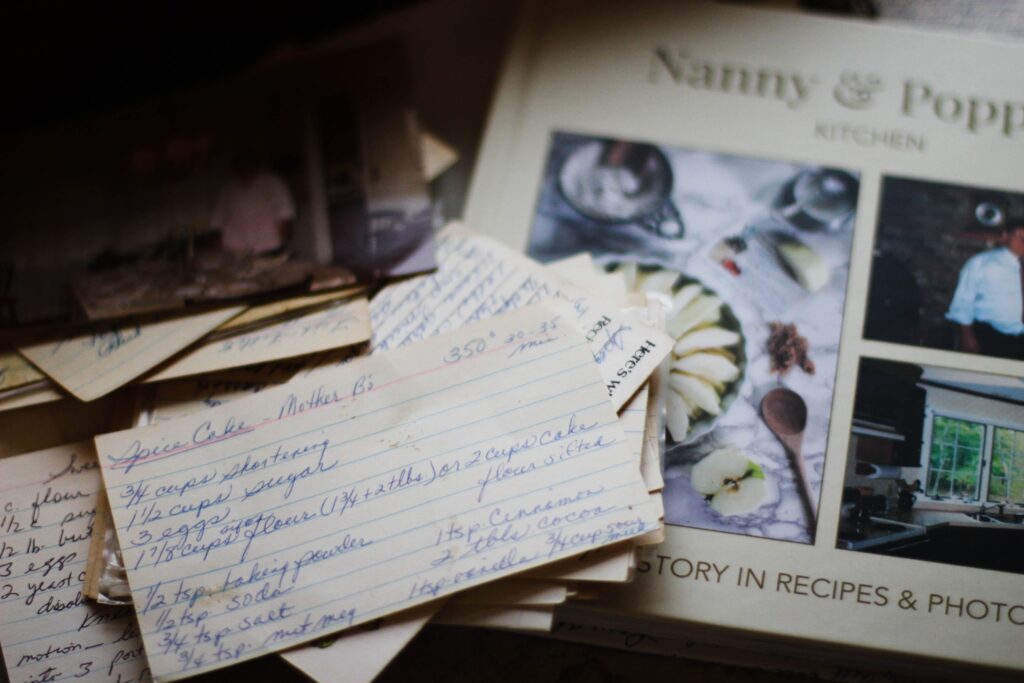Family recipes hold a special place in our hearts and kitchens. They are more than just instructions for preparing a dish; they are a link to our past, a way to celebrate family traditions, and a means of passing down cherished memories.
Creating a family cookbook is a wonderful way to preserve these recipes and share them with loved ones for generations to come. Here’s a comprehensive guide on how to create a custom cookbook, preserving and sharing Grandma’s treasured recipes.
1. Gather and Preserve Grandma’s Recipes
The first step in creating a family cookbook is to collect all of Grandma’s recipes. These can be found in various forms:
- Handwritten Notes: Old recipe cards or slips of paper with handwritten notes.
- Family Heirlooms: Recipe books or binders that Grandma used.
- Memories and Stories: Oral traditions or stories from family members about Grandma’s cooking.
Reach out to family members who may have additional recipes or memories. Collecting these recipes and stories will provide a complete picture of Grandma’s culinary legacy.
2. Organize and Transcribe Recipes
Once you have gathered all the recipes, it’s time to organize them. Categorizing recipes can make the cookbook more user-friendly. Common categories might include:
- Appetizers
- Main Courses
- Side Dishes
- Desserts
- Beverages
Transcribe the recipes into a digital format. This step not only helps in preserving the recipes but also allows for easy editing and formatting. Ensure you capture Grandma’s unique instructions, cooking tips, and any special notes she might have included.
3. Add Personal Touches
A family cookbook is more than just a collection of recipes; it’s a reflection of family history and tradition. Enhance your cookbook with personal touches:
- Anecdotes: Include stories about the recipes or special occasions when they were prepared. For example, a story about how Grandma’s apple pie was a favorite at family holidays.
- Photos: Add family photos, especially ones that feature Grandma in the kitchen or family gatherings around the table.
- Family Tree: Consider including a family tree or a brief history of Grandma’s life to give context to the recipes.
These additions will make the cookbook a cherished keepsake that family members will treasure.
4. Design the Cookbook
Designing the cookbook is where your vision starts to come to life. Choose between a physical or digital format based on your preference:
- Physical Cookbook: Use a design tool or service to create a visually appealing layout. Some many online platforms and services offer customizable templates for cookbooks. Opt for high-quality paper and binding options such as hardcover, softcover, or spiral binding to ensure durability.
- Digital Cookbook: For a more accessible and easily shareable option, create a digital cookbook. Tools like Google Docs, Canva, or specialized cookbook software allow you to design and format the cookbook. Digital cookbooks can be easily updated, shared via email, or stored in cloud services.
5. Print and Bind (for Physical Cookbooks)
If you opt for a physical cookbook, select a professional printing service to ensure high quality. Consider these options:
- Cover Design: Choose a cover that reflects the theme of the cookbook. It could feature a photo of Grandma, a family recipe, or a design that represents the family’s culinary heritage.
- Binding Options: Decide between hardcover, softcover, or spiral binding based on your budget and preferences. Hardcover books are more durable and make great gifts, while softcover and spiral-bound options are more cost-effective and flexible.
6. Share and Pass Down
Once your cookbook is ready, it’s time to share it with the family. Distribute physical copies during family gatherings or special occasions. For digital cookbooks, share the file through email or a cloud storage link so that everyone can easily access it.
Consider creating multiple copies or editions as the family grows or new recipes are added. Regular updates can keep the cookbook current and relevant.
Create a Family Cookbook: Start creating your own recipe book into a physical or digital cookbook that can be easily shared and passed down.
7. Update and Expand
A family cookbook can be a living document. As new recipes are developed or family traditions evolve, update the cookbook to include these changes. This ongoing process ensures that the cookbook remains a relevant and cherished family heirloom.
Creating a family cookbook is a rewarding project that not only preserves Grandma’s recipes but also brings family members together. It serves as a timeless reminder of shared meals, special occasions, and the love that binds us. By following these steps, you’ll create a valuable keepsake that will be cherished for generations to come.






